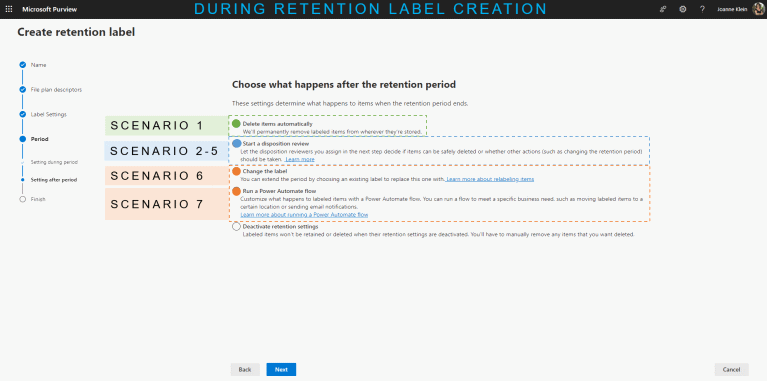A Purview Disposition Review Infographic
Quick post.
One of the important parts of managing the lifecycle of content is what happens to it at the end of the retention period… this is called its disposition. To describe this, I put together a 1-page infographic in my tip sheets (linked to below) to showcase the possible scenarios a labeled item will go thru once it reaches the end of its retention period, all based on the option you choose during label creation in Purview records management. This post is to put a bit of context around it.
Check out the disposition pages on my tip sheets for the infographic: My Purview DLM/RM Tip Sheets
Choosing what happens after the retention period (its disposition path) during retention label creation cannot be changed once the label is created making this a very important decision you must make. Below are the options available during label creation and the 7 resulting scenarios (I’m not including the last option below because I haven’t used it in a production scenario yet, although there may be use-cases for it):
… and the 7 resulting scenarios based on your selection:
Note: Some disposition settings CAN change after you’ve saved the label which I have documented below.
Scenario 2-5: If you’ve selected to “start a disposition review” in the label configuration, you can change who (user, group) is in each disposition stage and add a new stage. This is important to know if you currently only have 1 stage disposition, but you want to add more. Once saved, I don’t believe you can remove a stage.
Important! Now in preview, there is an “Automatic stage approval” setting for a retention label that will appear if you have chosen the “Start a disposition review” option (scenarios 2 thru 5). It will automatically approve a file for deletion if no action has been taken by a reviewer within a predetermined number of days (which you define).
Scenario 6: If you’ve selected to “Change the label” (sometimes referred to as daisy-chaining labels), you can change the retention label that is applied at the end of the retention period. This is important since you may decide to take a different path for content after the retention label has already been applied to content and awaiting disposition. Please know that this will not retroactively change existing labeled content that has already had the previous label applied to it thru this option.
Example: Retention Label A configured to change the label to Retention Label B at the end of the retention period. Some files have reached the end of their retention period and now have Retention Label B applied. You then change the setting for Retention Label A to change the label to Retention Label C instead. This will NOT change all files labeled with the previous daisy-chained label, Retention Label B, to Retention Label C. It will only do this for new files going forward.
Scenario 7: If you’ve selected to “Run a Power Automate flow”, you can change the Power Automate flow that is triggered. If you’ve built a new flow with additional capability and you want to replace the old flow, this is a good option. You can use the same flow for multiple retention labels if required.
Thanks for reading.
-JCK





